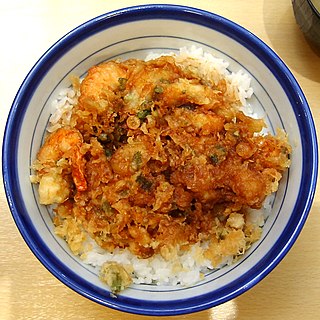Top Qs
Timeline
Chat
Perspective
Kakiage
Japanese seafood dish From Wikipedia, the free encyclopedia
Remove ads
Kakiage or kaki-age (かき揚げ, 掻き揚げ or かきあげ), a Japanese dish, is a type of tempura. It is made by batter-dipping and deep-frying a batch of ingredients such as shrimp bits (or a clump of small-sized shrimp). Kakiage may use other seafood such as small scallops, shredded vegetables or a combination of such ingredients.
General description
Summarize
Perspective


Kakiage is a type of tempura that uses small pieces of seafood, or vegetable or both.
Sometimes the main ingredients are clumps of fish or shellfish that are individually small,[1] or chopped into small pieces.[2]
The variety of seafood used include shrimp, mollusks like scallop,[2] or fish,[3][1] and can be combined with vegetables such as onion or mitsuba.[4] The kakiage may also use vegetarian ingredients such as carrots, burdock, or onions chopped into matchsticks[5][6] or into bits.[1]
Preparation
The lump being fried is shaped into disks,[a][6] and the kakiage are sometimes described as a "pancake" of sorts.[2] It is also referred to as a type of "fritter".[7][8]
The recipe may call for gently sliding the dollop of battered ingredients into hot oil,[6] and since it may try to break apart, a spatula may be used to hold it into place until the shape has set.[9] There is a modern-day implement being sold called a kakiage ring to assist in its cooking—a cylindrical, perforated sheet metal mold on a handle.[10]
In traditional preparation, these small pieces breaking apart must be constantly "raked together" (Japanese: kakiageru (掻き上げる)).[11]
Serving options
Kakiage may be eaten with tentsuyu or tempura dipping sauce and grated daikon radishes,[8] or with seasoned salt,[9] just like any other type of tempura.
It may also be served as a kakiage donburi or kakiage don, which is a rice bowl dish with a piece of kakiage placed on top of steamed rice.[12][7] A tendon (tempura bowl) may also include a piece of kakiage among other tempura morsels.[13]
Kakiage may top a bowl of kakesoba (hot soba in broth) or udon.[7]
Ingredients used in Japan
The kakiage typically uses a type of shrimp called shiba ebi (Metapenaeus spp.), whereas the individual whole shrimp tempura commonly uses both the shiba ebi and saimaki ebi (juvenile kuruma ebi).[14][15]
Another standard is using a type of small "scallops" called kobashira which are actually the adductor muscles of the bakagai or aoyagi clams (Mactra chinensis).[16][11]
Kakiage using fresh sakura shrimp are usually offered in the vicinity of Suruga Bay, Shizuoka Prefecture where these are caught,[17] although some recipes may call for the dried sakura shrimp which are more widely available.[18]
Remove ads
Etymology
The kakiage is so-named because one "mixes up" kakimazeru (かき混ぜる) the ingredients before they are fried, or so it has been claimed, e.g., by the tempura chef and proprietor of Tenkichi in Yokohama.[19]
Scholar Ikeda Yasaburō also introduces the same etymology, anecdotally quoting another tempura chef.[b][20]
History
Morisada mankō (written 1837–1853) stated that the tempura offered at soba noodle shops at the time used shiba ebi shrimp[21] (Metapenaeus joyneri). According to a soba researcher, tempura soba was invented around the Bunsei era (1818–1830), using the shiba ebi shrimp kakiage as topping.[22][23]
The former shogun Tokugawa Yoshinobu (1837–1913) was a regular customer at the tempura restaurant Tenkin, where he would order an especially large kakiage, served on a Nabeshima plate.[24]
See also
Explanatory notes
- This chef was lecturing to a customer that the kakiage he ordered was not deep-fried kaki, which would be kaki furai.
Citations
Wikiwand - on
Seamless Wikipedia browsing. On steroids.
Remove ads

